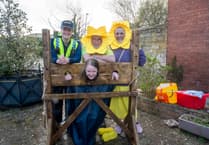What did the Romans ever do for Monmouthshire?
Well, quite a lot, as it happens, as will be explained this Friday (October 20) in a talk to Monmouth Field and History Society by the senior curator of archaeology at the Roman Legionary Museum in Caerleon.
Dr Mark Lewis, who has also been excavating the Iron Age fort in the Buckholt this year, will speak on “Roman, Medieval, Victorian and Edwardian Caerwent: Geophysical surveys and excavation at the parish church of St Stephen and St Tathan.” His talk is at Monmouth Priory at 7pm and guests are welcome (£5).
The Romans merit frequent mentions in Steve Clarke’s masterly “Down the Dig – An Adventure in Archaeology in Monmouth”, culminating in a straight twenty pages culminating in how he found his new printingshop was built on top of the fort dating back to the very early days of the Roman invasion.
Roman sherds and glass have been found between the castle and the Wye, all down Monnow Street and into Overmonnow. The foundation slots of a Roman wooden building were found at 22-24 Monnow Street.
But “Down the Dig” predates by a few years what is perhaps Mr Clarke’s greatest discovery, that for hundreds – perhaps thousands – of years, the site of Monmouth was under a huge lake caused by an Ice Age blockage of the Wye gorge towards Redbrook. That lake disappeared about the time the Romans arrived and it is highly plausible that they cleared the dam and allowed Monmouth – or Blestium, as they called it – to begin its story as one of a chain of Roman forts and settlements.
The Roman’s general, Sextus Julius Frontinus, was not only a brilliant water engineer (he went on to sort out Rome’s aqueducts), but an inspired administrator who brought peace with the fierce tribe of Silures and encouraged them to settle at Venta Silurum, or Caerwent as we know it. The town has extensive remains above and below ground, but its importance as a civil centre in Roman Britain has been overshadowed by the military hub of nearby Caerleon with its barracks and Arthurian amphitheatre.




